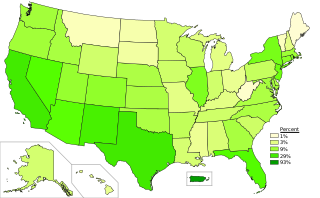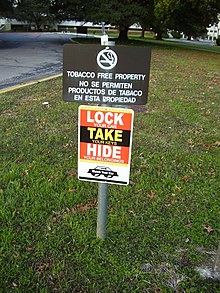The masculine term Latino, along with its feminine form Latina, is a noun and adjective, often used in English, Spanish, and Portuguese, that most commonly refers to United States inhabitants who have cultural ties to Latin America.

Spanish or Castilian (castellano) is a Romance language of the Indo-European language family that evolved from the Vulgar Latin spoken on the Iberian Peninsula of Europe. Today, it is a global language with about 500 million native speakers, mainly in the Americas and Spain, and about 600 million speakers including second language speakers. Spanish is the official language of 20 countries, as well as one of the six official languages of the United Nations. Spanish is the world's second-most spoken native language after Mandarin Chinese; the world's fourth-most spoken language overall after English, Mandarin Chinese, and Hindustani (Hindi-Urdu); and the world's most widely spoken Romance language. The country with the largest population of native speakers is Mexico.

The United States does not have an official language at the federal level, but the most commonly used language is English, which is the de facto national language. In addition, 32 U.S. states out of 50 and all five U.S. territories have declared English as an official language. The majority of the U.S. population (78%) speaks only English at home as of 2023. The remainder of the population speaks many other languages at home, most notably Spanish, according to the American Community Survey (ACS) of the U.S. Census Bureau; others include indigenous languages originally spoken by Native Americans, Alaska Natives, Native Hawaiians, and native populations in the U.S. unincorporated territories. Other languages were brought in by people from Europe, Africa, Asia, other parts of the Americas, and Oceania, including multiple dialects, creole languages, pidgin languages, and sign languages originating in what is now the United States. Interlingua, an international auxiliary language, was also created in the U.S.

Spanglish is any language variety that results from conversationally combining Spanish and English. The term is mostly used in the United States and refers to a blend of the words and grammar of the two languages. More narrowly, Spanglish can specifically mean a variety of Spanish with heavy use of English loanwords.

The different dialects of the Spanish language spoken in the Americas are distinct from each other, as well as from those varieties spoken in the Iberian Peninsula and the Spanish Mediterranean islands—collectively known as Peninsular Spanish—and Spanish spoken elsewhere, such as in Equatorial Guinea, Western Sahara, or in the Philippines. There is great diversity among the various Latin American vernaculars, as there are no common traits shared by all of them which are not also in existence in one or more of the variants of Iberian Spanish. A general Latin American "standard" does, however, vary from the Castilian "standard" register used in television, music and, notably, in the dubbing industry. Of the more than 498 million people who speak Spanish as their native language, more than 455 million are in Latin America, the United States and Canada, as of 2022. The total amount of native and non-native speakers of Spanish as of October 2022 well-exceeds 595 million.

Some of the regional varieties of the Spanish language are quite divergent from one another, especially in pronunciation and vocabulary, and less so in grammar.

Hispanophone refers to anything related to the Spanish language.

Hispanic and Latino Americans are Americans of full or partial Spanish and/or Latin American background, culture, or family origin. These demographics include all Americans who identify as Hispanic or Latino regardless of race. As of 2020, the Census Bureau estimated that there were almost 65.3 million Hispanics and Latinos living in the United States and its territories.

Chicano English, or Mexican-American English, is a dialect of American English spoken primarily by Mexican Americans, particularly in the Southwestern United States ranging from Texas to California, as well as in Chicago. Chicano English is sometimes mistakenly conflated with Spanglish, which is a mixing of Spanish and English; however, Chicano English is a fully formed and native dialect of English, not a "learner English" or interlanguage. It is even the native dialect of some speakers who know little to no Spanish, or have no Mexican heritage.

Puerto Rican Spanish is the variety of the Spanish language as characteristically spoken in Puerto Rico and by millions of people of Puerto Rican descent living in the United States and elsewhere. It belongs to the group of Caribbean Spanish variants and, as such, is largely derived from Canarian Spanish and Andalusian Spanish. Outside of Puerto Rico, the Puerto Rican accent of Spanish is also commonly heard in the U.S. Virgin Islands and many U.S. mainland cities like Orlando, New York City, Philadelphia, Miami, Tampa, Boston, Cleveland, and Chicago, among others. However, not all stateside Puerto Ricans have knowledge of Spanish. Opposite to island-born Puerto Ricans who primarily speak Spanish, many stateside-born Puerto Ricans primarily speak English, although many stateside Puerto-Ricans are fluent in Spanish and English, and often alternate between the two languages.

Caribbean Spanish is the general name of the Spanish dialects spoken in the Caribbean region. The Spanish language was introduced to the Caribbean in 1492 with the voyages of Christopher Columbus. It resembles the Spanish spoken in the Canary Islands, and, more distantly, the Spanish of western Andalusia. With more than 25 million speakers, Spanish is the most widely spoken language in the Caribbean Islands.

Central American Spanish is the general name of the Spanish language dialects spoken in Central America. More precisely, the term refers to the Spanish language as spoken in Costa Rica, El Salvador, Guatemala, Honduras, and Nicaragua. Panamanian Spanish is considered a variety of Caribbean Spanish, it is transitional between Central American and Caribbean dialects.

New Mexican Spanish refers to the varieties of Spanish spoken in the United States in New Mexico and southern Colorado. It includes an endangered traditional indigenous dialect spoken generally by Oasisamerican peoples and Hispano—descendants, who live mostly in New Mexico, southern Colorado, in Pueblos, Jicarilla, Mescalero, the Navajo Nation, and in other parts of the former regions of Nuevo Mexico and the New Mexico Territory.

Salvadoran Americans are Americans of full or partial Salvadoran descent. As of 2021, there are 2,473,947 Salvadoran Americans in the United States, the third-largest Hispanic community by nation of ancestry. According to the Census Bureau, in 2021 Salvadorans made up 4.0% of the total Hispanic population in the United States.

Peninsular Spanish, also known as the Spanish of Spain, European Spanish, or Iberian Spanish, is the set of varieties of the Spanish language spoken in Peninsular Spain. This construct is often framed in opposition to varieties from the Americas and the Canary Islands.

Nicaraguan Spanish is geographically defined as the form of Spanish spoken in Nicaragua. Affectionately, Nicaraguan Spanish is often called Nicañol.

Salvadoran Spanish is geographically defined as the form of Spanish spoken in the country of El Salvador. The Spanish dialect in El Salvador shares many similarities to that of its neighbors in the region, but it has its stark differences in pronunciation and usage. El Salvador, like most of Central America, uses voseo Spanish as its written and spoken form, similar to that of Argentina. Vos is used, but many Salvadorans understand tuteo. Vos can be heard in television programs and can be seen in written form in publications. Usted is used as a show of respect, when someone is speaking to an elderly person.

Hispanic and Latino Californians are residents of the state of California who are of full or partial Hispanic or Latino ancestry. As of the 2020 U.S. Census, Hispanics and Latinos of any race were 39.4% of the state's population, making it the largest ethnicity in California.
Hispanic and Latino New Mexicans are residents of the state of New Mexico who are of Hispanic or Latino ancestry. As of the 2020 U.S. Census, Hispanics and Latinos of any race were 49.3% of the state's population.

The history of Hispanics and Latinos in Baltimore dates back to the mid-20th century. The Hispanic and Latino community of Baltimore is the fastest growing ethnic group in the city. There is a significant Hispanic/Latino presence in many Southeast Baltimore neighborhoods, particularly Highlandtown, Upper Fell's Point, and Greektown. Overall Baltimore has a small but growing Hispanic population, primarily in the Southeast portion of the area from Fells Point to Dundalk.
























